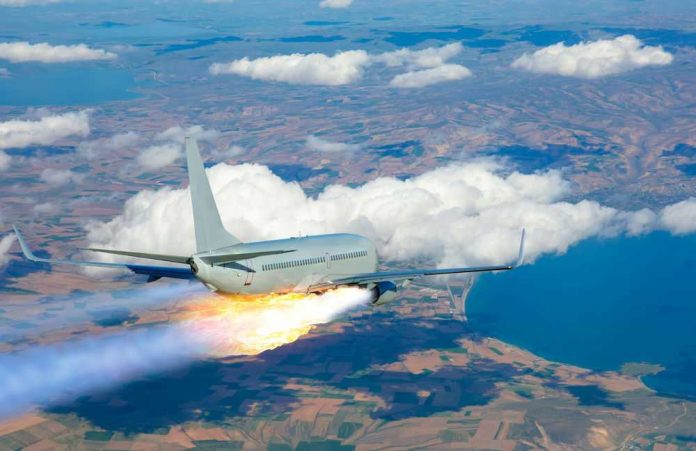🔴 Website 👉 https://u-s-news.com/
Telegram 👉 https://t.me/usnewscom_channel
A Boeing aircraft’s engine explosion forced terrified passengers to send farewell texts as flames erupted mid-flight, exposing yet another catastrophic failure in aviation safety that should alarm every American who values competent oversight and accountability.
Story Snapshot
- Boeing 767 engine caught fire shortly after takeoff, forcing emergency landing
- Passengers feared for their lives, sending goodbye messages to loved ones
- Incident highlights ongoing Boeing safety concerns and regulatory failures
- Aviation industry faces mounting scrutiny over repeated mechanical failures
Engine Explosion Creates Mid-Air Terror
The Delta Airlines Boeing 767 experienced a catastrophic engine failure shortly after takeoff, with flames visible shooting from the aircraft’s engine. Passengers aboard the flight witnessed the terrifying spectacle as fire engulfed the engine, prompting immediate panic and desperate communications with family members. The crew executed emergency procedures while passengers prepared for what many believed could be their final moments. This incident represents another alarming example of mechanical failures that have plagued Boeing aircraft in recent years.
Flight attendants worked to maintain order while pilots coordinated with air traffic control for an immediate return to Los Angeles International Airport. The aircraft successfully completed an emergency landing despite the engine fire, demonstrating the crew’s professional training under extreme pressure. However, the psychological trauma inflicted on passengers raises serious questions about aircraft maintenance protocols and manufacturer quality control standards that should concern every American traveler.
Regulatory Failures Expose Systemic Problems
This engine fire incident occurs amid a troubling pattern of aviation safety lapses that have escalated dramatically under previous administrations’ weak oversight. FAA data reveals a staggering 65% increase in significant air control lapses between 2022-2023, with 503 documented incidents primarily affecting major airports. These failures represent a fundamental breakdown in the regulatory framework that protects American families who depend on safe air travel for business and personal needs.
The aviation industry’s response has been inadequate, with officials offering hollow reassurances while systemic problems persist unchecked. Air traffic control staffing shortages and procedural errors continue to threaten passenger safety, yet bureaucratic inertia prevents meaningful reforms. This represents exactly the kind of government incompetence that frustrates hardworking Americans who expect basic safety standards from federal agencies they fund through their tax dollars.
Industry Alliance Promises Overdue Reforms
Aviation leaders have finally formed an industry alliance focused on air traffic control modernization and enhanced pilot training protocols. This collaborative effort aims to address the mounting safety concerns that have eroded public confidence in commercial aviation. The alliance represents a departure from previous reactive approaches, emphasizing proactive measures to prevent future incidents that terrorize passengers and families.
“It was an incredibly horrible experience. I already sent goodbye texts because I thought, ‘It’s over now,’” another added.https://t.co/9ij3aXIu3s
— FloridaGirl 🍊 (@EyesOnThePlan) August 19, 2025
The Department of Transportation has announced new enforcement discretion measures and updated consumer protection rules responding to public outcry over aviation safety failures. These regulatory changes signal recognition that current oversight mechanisms have failed to protect American travelers adequately. However, the effectiveness of these reforms depends entirely on rigorous implementation and accountability measures that have been lacking under previous regulatory approaches that prioritized industry interests over passenger safety.
Sources:
Why Air Travel in 2025 Remains One of the Safest Ways to Travel
